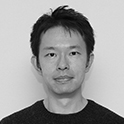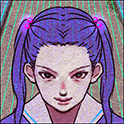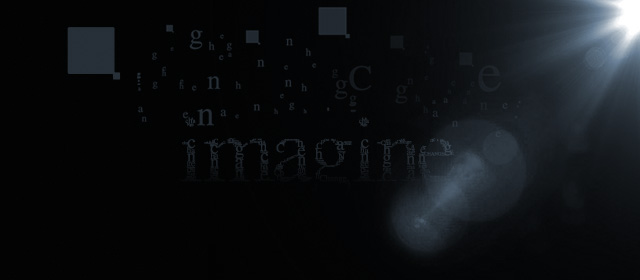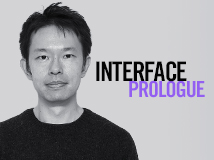INTERFACE
STORY 3/3
Transitory and Moving to the New: TAKASHI KURATA
February 9, 2016
Interfaces in 2036, imagined by sci-fi author Takashi Kurata, is introduced in seven segments, four from a short story and three from an interview with him. This is the second in a three-part series of the short story. Three individuals who are locked in a cylindrical paper office try to escape by using one’s solution to reboot the office, but fail. It was in that situation that another proposed the idea of using a paper gun.
Old Logic, New Logic
Every day, from a newly created environment, comes an on-going experience of even more complete and fundamental innovation. A completely interactive office, where all is temporal and disposable.
Concept proposal for the paper office: The struggle to search for a new idea is also a struggle with the past within yourself.
Tomi spoke quickly as he explained. “As for acquiring the origami code earlier, I only have limited authority for this specific work space in the Papel Nova office system. Removing the general standards of maintaining security requires even higher levels of authorization.”
The corners of Sasanami’s mouth turned up and she nodded. “In the real sense of the term, that origami was not the ‘backdoor key,’ was it?”
Tomi crouched down, bellowed and stared at the floor. “Damn it, I should have thought of that.”
Humans were prohibited from being taken away because the paper office system recognized them as confidential information, just like mobile memory. That is why they couldn’t leave. “The office is just too smart,” Yoshida laughed.
Ordinarily the limit on how much data could be move around in a workspace was high. In other words, it does not matter how much output was made onto paper, and did not matter how many copies were made. That was because Papel Nova media was built on the premise that it could erase the data. Instead, a complete limit was set on how much data could be taken outside the office. Basically, if data was transferred to a recording device other than the Papel Nova devices, such as a mobile memory, and one then tried to leave the office with that media, the door would not open.
On the other hand, to develop the paper as an urban infrastructure, Tomi added functionality that recognized individual human beings as an assembly of information. Users, who in the past would receive and process information, had come to be treated as one type of database. And this is what the extended version of the system could accomplish.
“You have a situation where the logic of the old and the logic of the new are in conflict,” Yoshida said.
“Yes that is exactly right. That is true,” responded Tomi while still bending down. Still speaking in a mumbling voice, he started working on an updated plan in his head. It was now understood what was in conflict. It was not that difficult to avoid this conflict. If he had one day, he thought it could be solved. Yes, yes. It was time to go for it!
Tomi stood up with a refreshed expression on his face and looked at the other two. “Okay, do you want to destroy it?”
Sasanami’s eyes widened to circles. “Huh, is that okay…. I mean can we destroy it?”
“As I expected, it is not so strong that three adults can’t destroy it.”
“But even if we destroy it, it will take two days to repair, right?”
Yoshida posed in thought, “I really enjoy destroying things, but there is still probably another way to go about this. I can still stand it, why don’t we put some more thought into it.”
“I know! Wait, use this.” Sasanami searched her bag and pulled out a strip of paper.
Tomi was surprised and leaned his face closer.
“Oh so you still have that?”
It was a prototype for a smart bank bill that was not commercially viable. The Papel Nova company developed it on a test basis, but decided to abandon the project when they came to the conclusion that the concept of paper money was coming to an end.
It was different from usual Papel Nova in that it was imbedded with a thin processor that had high calculation capabilities.
Next Sasanami took out a small pouch and from that a somewhat large pill. She put it in her mouth and unappetizingly crunched it. She said, “Excuse me.” And after turning in the opposite direction, she started to diligently lick one side of the smart bank note as if she were a child licking the lid of an ice cream container.
“Bad manners.” Yoshida said, bursting into laugher.
She then casually stared and said, “I guess it can’t be helped since we didn’t bring water.”
The side that she licked she stuck to the wall. Then the area of the Papel Novel wall where the note was attached began to react. From the side of the bank note, an input window emerged like a square swelling bubble. The window was activated.
“Is that a binder?”
“Yes, it’s the one I use for the volunteer corps.”
The pill that Sasanami put in her mouth contained the same functional material that connected the Papel Nova fiber together. That material dissolved in saliva and could then transmit a signal. The bank note was stuck to the paper wall and became a type of negotiator with the paper office, and the connection was confirmed.
“Well then, please proceed.” Sasanami stepped back and bowed to Tomi.
Tomi, showing the same respect, replied, “Thank you very much,” and then focused on the open menu in front of him. Using Sasanami’s trick he was only trying to make possible a somewhat higher level of manipulation.
As usual he did not have authorization to bypass security regulations and open the door. However, there was one thing that he could do. Tomi could put in his authentication code. He selected that from the menu.
The paper office demonstration began.
Beyond Paper
On the inside of the cylindrical walls were displayed many windows that were overlapping and lined up. Each window showed a landscape scene or images of office utilization. It had now become one big screen and was shining with brilliance.
The following moving images appeared in succession: A child poking a hole in shoji with a finger and peering outside; a paper mask made with a mechanism that allowed it to change expressions; an image of a poorly written large hiragana phonetic symbol that was revealed when paper was heated; a strip of paper with a wish written on it that wavered in the wind; a folded letter from a sheet of notebook paper that was quietly passed around during class.
Letters were written on paper with a quill pen, with a pencil, with a typewriter, with an ink-jet….
A shower of paper pieces fluttered down from the ceiling and simultaneously the same video images were displayed.
In the moving images Papel Nova appeared. The pieces of paper danced about the office like a spring storm and blew around the men and women at work.
The pieces of paper blew out into the town. The moving images flowed to the edge opposite the entrance of the cylindrical paper office.
Shining pieces of paper changed form and were each given different roles in town.
They brought information. Put around wrists, they informed people of where the streets weren’t congested.
They mediated. They were handed out as fans at festivals and were able to interpret for the foreign visitors.
And they were released from the limitations of the paper form. They became a formless interface that floated between people and works on the stage that did not arise in consciousness.
Through the flowing interface, the lives of people were eased. There was a connection but they were not bound, and while they were gathered, they were free, and a society could be created where harmony was maintained through this transience.
And before the three individuals knew it, the back wall opened, and they could see an exhibit space lit with the night illumination. There at the end of the line of sight was a model of an idealized city. It would be welcoming people brightly when opened.
Tomi sighed deeply. Sasanami and Yoshida applauded.
Sasanami muttered in a low voice, “It seems that we should change society to be more like that.”
“If we could realize about 30 percent, that would provide me with great satisfaction,” said Yoshida.
“Sorry for keeping you restrained so late. I kind of slacked off at the end.”
Yoshida thanked the grateful Tomi. “It was good that a large debugging was achieved within this year.”
Tomi let out a sigh.
“Huh, it seems that it is still going to take time, doesn’t it. I just can’t manage to keep up with what Sasanami and Yoshida are doing.”
“Tomi, what you are doing is the most important.”
Sasanami also said, to encourage him, “And precisely because there is a foundation of technology, there are applications. The volunteer corps owes Tomi for their successful activities because Tomi’s company developed this technology, and provided a way for that to be available inexpensively, and the equipment was disseminated nationwide. And it is because the company had that power, that the situation was changed.”
It sounded unrealistic, Sasanami proposed, saying, “For the first time in human history, the time may come when good wins in the real sense of the word. And 2036 possibly may be recorded as the beginning of such an era. And when you think of that don’t you get excited?”
Yoshida’s grinning face produced an expression that showed a touch of a bitter smile. As for him, he could not easily believe that, because his home was that planet. But, he would have liked to believe it.
“Will you help me with this?” Sasanami displayed a hopeful gaze.
“I am doing that now.” Yoshida nodded his head in a benevolent way.
“Tomi, stay a good a person. Even if in the future you have great power, don’t change that part of your personality.”
Responding to Sasanami’s words, Tomi gave a small nod. He held his feet apart as if he was facing the wind and put both hands into his pockets. “Rest assured, I will definitely stick to my principles.”
In his head, Tomi was working on an upgrade plan for the beginning of the New Year. He thought he now had confidence to handle it. He was sure he could do it.
The automatic door to the exhibition space opened, fresh air and the clamor of the year-end came surging in.
Sasanami pushed the information terminal behind her ear, and the voice of her husband came through. “Were the two kids good? Okay, well from now I think I’ll go for a drink before returning home. Thanks, see you.”
Fireworks were exploding over the beach. The clock display turned to midnight. It was the New Year.
Sasanami said, “Okay, it’s my treat!”
“No, this one should be on me,” Tomi responded.
Yoshida asked, “Is it okay if I don’t even pay a single yen?”
“Anything is fine. Let’s have some drinks and go home!” Sasanami gave an instruction to her terminal and a driverless taxi stopped on a street just ahead.
The three ran.
Yoshida, in front, made a fist with both arms raised, and as they all let out a victory cry they ran between the passing people and jumped into the car.
PROFILE
-

-
Takashi KurataAuthor
Born in Saitama in 1971. After discontinuing studies at Tokyo Metropolitan University Section 2, Engineering Department, Electronic Information Department, Kurata worked as both an illustrator and cartoonist while working for a company that developed course materials for the web. After working free-lance in the web development industry, Kurata debuted in 2010 as a science fiction author. In 2015, with publishing his novel, Haha Ni Naru, Ishino Tsubute De, he was a finalist in the Second Hayakawa Sci-fi Contest.
-

-
ZainIllustrator
Zain has received high acclaim in Japan and abroad for combining edgy illustrations with dynamic spaces and pop art. Active on various fronts, Zain even worked on a collaborative advertisement with Hatsune Miku for Toyota America. She has created artwork for CD jackets as well as artwork for the cover and story of a novella.



















